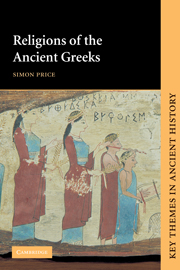Book contents
- Frontmatter
- Contents
- List of figures
- Preface
- List of abbreviations
- 1 Introduction
- 2 Gods, myths and festivals
- 3 Religious places
- 4 Authority, control and crisis
- 5 Girls and boys, women and men
- 6 Elective cults
- 7 Greek thinkers
- 8 Reactions to Greek religions
- Appendix of Greek inscriptions in translation
- Bibliographical essay
- Bibliography
- Index
5 - Girls and boys, women and men
Published online by Cambridge University Press: 05 June 2016
- Frontmatter
- Contents
- List of figures
- Preface
- List of abbreviations
- 1 Introduction
- 2 Gods, myths and festivals
- 3 Religious places
- 4 Authority, control and crisis
- 5 Girls and boys, women and men
- 6 Elective cults
- 7 Greek thinkers
- 8 Reactions to Greek religions
- Appendix of Greek inscriptions in translation
- Bibliographical essay
- Bibliography
- Index
Summary
Greek religion was certainly not a formality affecting only the public life of the community, but rather it was embedded in all aspects of ancient life. This does not mean, however, that it gave all these aspects an allembracing religious significance. It is also a mistake to imagine that areas which possess such a significance for Christianity today can be assigned their ancient equivalents. The modern Christian services for birth, marriage and death have no exact ancient equivalent. Furthermore, it is unhelpful to search for ‘the religion of the Greek household’ as the prime locus of Greek religiosity. Archaeologically Greek houses had no separate room for a household shrine and rarely had special permanent altars. And the literary evidence, by its silence on this subject, also suggests strongly that the family is not the basic ideological unit of Greek religion. Rather one should see the individual as a basic unit operating within the overall framework of the private and public worship of the gods. This chapter will therefore focus on the individual citizen from birth to death, distinguishing throughout between the rituals appropriate for males and those for females.
CHILDREN
The birth of a child was not marked by a formal religious service, like modern christenings. Though our evidence is meagre and mainly poor in quality, it seems that (so long as the father had agreed the child should be reared) the five-day-old child was carried around the hearth, the symbolic centre of the house, perhaps by its parents and that five days later a party was held to celebrate the birth.
- Type
- Chapter
- Information
- Religions of the Ancient Greeks , pp. 89 - 107Publisher: Cambridge University PressPrint publication year: 1999

